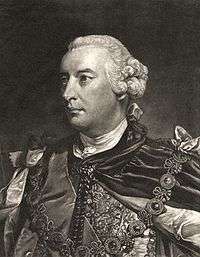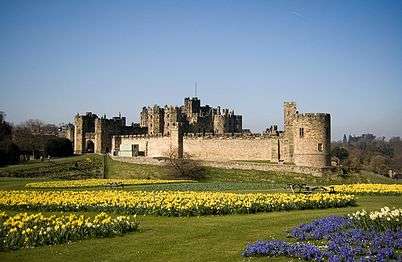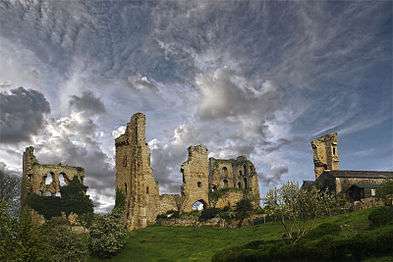House of Percy
| House of Percy | |
|---|---|
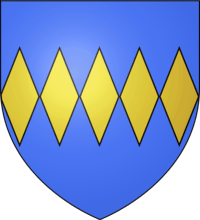 Armorial of Percy | |
| Country | Kingdom of England, United Kingdom |
| Titles | |
| Founded | 1067 |
| Founder | William de Percy (d.1096), 1st feudal baron of Topcliffe |
| Current head | Ralph Percy, 12th Duke of Northumberland |

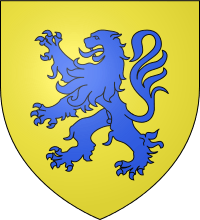
The House of Percy (old French Perci) were the most powerful noble family in northern England for much of the Middle Ages, having descended from William de Percy (d.1096), a Norman who crossed over to England after William the Conqueror in early December 1067, was created 1st feudal baron of Topcliffe in Yorkshire,[4] and was rebuilding York Castle in 1070. The name derives from the manor of Percy-en-Auge in Normandy, the home of the family at the time of the Norman Conquest.[5] Members have held the titles of Earl of Northumberland or Duke of Northumberland to this day, in addition to Baron Percy and other titles. The Percy surname twice died out in the male line but was re-adopted by the husband of a Percy heiress and by their descendants. In the 12th century, the original Percy line was represented by Agnes de Percy, whose son by her husband Joscelin of Louvain adopted the surname Percy. Again in the 18th century, the heiress Elizabeth Seymour married Sir Hugh Smithson, who adopted the surname Percy and was created Duke of Northumberland.[6]
Earls of Northumberland
William de Percy, 1st Baron Percy, who came from the village of Percy in Normandy, was in the train of William I. After arriving in England following the Harrying of the North (1069–70), he was bestowed modest estates in Yorkshire by Hugh d'Avranches. However, by the reign of Henry II the family was represented by only an heiress, Agnes de Percy (d.1203) following the death of the third feudal baron. As her dowry contained the manor of Topcliffe in Yorkshire, Adeliza of Louvain, the widowed and remarried second wife of Henry I, arranged the marriage of Agnes with her own young half-brother, Joscelin of Louvain. After their wedding, the nobleman from the Duchy of Brabant in the Holy Roman Empire settled in England. He adopted the surname Percy and his descendants were later created Earls of Northumberland. The Percys' line would go on to play a large role in the history of both England and Scotland. As nearly every Percy was a Warden of the Marches, Scottish affairs were often of more concern than those in England.[7]
In 1309 Henry de Percy, 1st Baron Percy purchased Alnwick Castle from Antony Bek, Bishop of Durham. The castle had been founded in the late 11th century by Ivo de Vesci, a Norman nobleman from Vassy, Calvados in Normandy. However, by the early 14th century, the English line of the De Vesci family had become extinct. The family's property and estates had been put into the guardianship of Bek, who sold them to the Percys. From this time the fortunes of the Percys, though they still held their Yorkshire lands and titles, were linked permanently with Alnwick and its castle.
Henry de Percy, 2nd Baron Percy, who was granted the lands of Patrick IV, Earl of March, in Northumberland, by Edward II in 1316, began to improve the size and defences of the castle. He was appointed to Edward III's Council in 1327 and was given the manor and castle of Skipton. Was granted, by Edward III, the castle and barony of Warkworth in 1328. He was at the siege of Dunbar and the Battle of Halidon Hill and was subsequently appointed constable of Berwick-upon-Tweed. In 1346, Henry commanded the right wing of the English Army which defeated a larger Scottish force at the Battle of Neville's Cross. His son, Henry de Percy, 3rd Baron Percy married Mary of Lancaster, an aunt of John of Gaunt's wife Blanche of Lancaster.[7] In 1377 the next Henry Percy, was created Earl of Northumberland, which title he was given after the coronation of Richard II. Nor was this all, for he was that Northumberland whose doings in the next reign fill so large a part of Shakespeare's Henry IV, and he was the father of the most famous Percy of all, Henry Percy the fifth, better known as "Hotspur." Hotspur never became Earl of Northumberland, being slain at Shrewsbury in the lifetime of his father, whose estates were forfeited under attainder on account of the rebellion of himself and his son against King Henry IV.[7] Henry V restored Hotspur's son, the second Earl, to his family honours, and the Percys were staunch Lancastrians during the Wars of the Roses which followed, the third Earl and three of his brothers losing their lives in the cause.[7]
The fourth Earl was involved in the political manoeuvrings of the last Yorkist kings Edward IV and Richard III. Either through indecision or treachery, he did not respond in a timely manner at the Battle of Bosworth Field, and thus helped cause his ally Richard III's defeat at the hands of Henry Tudor (who became Henry VII). In 1489, he was pulled from his horse and murdered by some of his tenants.
The fifth Earl displayed magnificence in his tastes, and being one of the richest magnates of his day, kept a very large household establishment.
Henry Percy, the sixth Earl of Northumberland, loved Anne Boleyn, and was her accepted suitor before Henry VIII married her. He married later to the daughter of the Earl of Shrewsbury, but as he died without a son, his nephew, Thomas Percy became the seventh Earl.[7]
Thereafter, a succession of plots and counterplots—the Rising of the North, the plots to liberate Mary Queen of Scots, and the Gunpowder Plot – each claimed a Percy among their adherents. On this account the eighth and ninth Earls spent many years in the Tower, but the tenth Earl, Algernon, fought for King Charles in the Civil War, the male line of the Percy-Louvain house ending with Josceline, the eleventh Earl. The heiress to the vast Percy estates married the Duke of Somerset; and her granddaughter married a Yorkshire knight, Sir Hugh Smithson, who in 1766 was created the first Duke of Northumberland and Earl Percy, and it is their descendants who now represent the famous old house.[7] One of Sir Hugh's illegitimate sons, James Smithson, left behind a bequest to found the Smithsonian Institution.
The current duke lives at Alnwick Castle and Syon House, just outside London. Parts of the Harry Potter movies were shot at Alnwick, and there is a scene in The Madness of King George (when Pitt walks backward from the king down a long corridor) filmed at Syon.
Dukes of Northumberland
The title was created for the third time in 1766 for Hugh Percy, 2nd Earl of Northumberland, the former Sir Hugh Smithson, 4th Baronet (1714–1786), who had assumed by Act of Parliament in 1750 for himself and his descendants the surname Percy, due to his having married in 1740 the daughter of Algernon Seymour, 7th Duke of Somerset (1684–1750), whose mother Lady Elizabeth Percy (1667–1722), was the last of the senior blood line of the ancient House of Percy, being the only surviving child of Joceline Percy, 11th Earl of Northumberland (1644–1670). In 1749 King George II created Algernon who had inherited the Dukedom of Somerset in 1748 Earl of Northumberland and by courtesy title (for eldest male heir) Baron Warkworth, of Warkworth Castle in the County of Northumberland with special remainder to his son-in-law Sir Hugh Smithson, 4th Baronet.[8][9]
The above steps formed a deliberate move to allow ancient names and titles of the Percys to be revived in the male-heir exhausted senior branch of the Dukedom of Somerset which at that time was about to see its largest removal, to another noble but very cadet branch (a fourth cousin) on Algernon's death; Algernon was also created Earl of Egremont at the same time with a different remainder – see this article for further information).[10]
In 1784 the 1st Duke was also granted the substantive title Lord Lovaine, Baron of Alnwick in the County of Northumberland, in the Peerage of Great Britain, with remainder to his second son Lord Algernon Percy,[11] who succeeded and who was created Earl of Beverley in 1790 and thus it too became a courtesy title.[12]
The Duke was succeeded in the dukedom and associated titles by his eldest son, Hugh, the 2nd Duke, a Lieutenant-General in the British Army. The 2nd Duke was in his turn succeeded by his eldest son, Hugh, the 3rd Duke, who in 1812, five years before he succeeded in the dukedom, had been summoned to the House of Lords through a writ of acceleration in his father's junior title of Baron Percy.[13] The 3rd Duke later held office as Lord-Lieutenant of Ireland from 1829 to 1830. He was childless and was succeeded by his younger brother, Algernon, 1st Baron Prudhoe, the 4th Duke, who in 1814 had been created Baron Prudhoe, of Prudhoe Castle in the County of Northumberland, in the Peerage of the United Kingdom.[14] The 4th Duke was an Admiral in the Royal Navy and notably served as First Lord of the Admiralty in 1852. He was also childless and on his death in 1865 the barony of Prudhoe became extinct while the barony of Percy (which could be passed on through the female line) was inherited by his great-nephew, John Stewart-Murray, 7th Duke of Atholl. The Admiral was succeeded in the dukedom and remaining titles by his first cousin, George, the 2nd Earl of Beverley, eldest son of the second son of the 1st Duke. The barony of Lovaine and earldom of Beverley have since been merged in the dukedom as courtesy titles.
The 5th Duke was succeeded by his eldest son, Algernon, the 6th Duke, who notably served as Lord Privy Seal between 1879 and 1880 under Lord Beaconsfield. The 6th Duke's eldest son, Henry, the 7th Duke, was summoned to the House of lords through a writ of acceleration in his father's junior title of Lord Lovaine in 1887.[15] The 7th Duke's eldest son, Henry Percy, Earl Percy, predeceased him. He was succeeded by his fourth but eldest surviving son, Alan, the 8th Duke, whose eldest son, Henry, the 9th Duke, was killed during the retreat to Dunkirk during the Second World War. Henry was succeeded by his younger brother, Hugh, the 10th Duke. In 1957, on the death of his fourth cousin once removed, James Stewart-Murray, 9th Duke of Atholl, Hugh succeeded as 9th Baron Percy, the title thus re-merging with the Dukedom. As of 2012 the titles are held by his second son, Ralph, the 12th Duke, who succeeded on the death of his elder brother in 1995.
Several other members of the Percy family have also gained distinction. James Smithson, illegitimate son of the first Duke, was a chemist and mineralogist and the founding donor of the Smithsonian Institution. Charlotte Percy, Duchess of Northumberland, wife of the third Duke, was governess of the future Queen Victoria. Lord Josceline Percy, second son of the fifth Duke, was a politician. Lord Henry Percy, third son of the fifth Duke, was a soldier. Lord Algernon Percy, second son of the sixth Duke, was a politician. Lord Eustace Percy, seventh son of the seventh Duke, was a politician who was raised to the peerage as Baron Percy of Newcastle in 1953. Jane Percy, Duchess of Northumberland, wife of the twelfth Duke, is Lord-Lieutenant of Northumberland since 2009. See also Earl of Beverley for younger sons of the first Earl of Beverley.
Family residences
The seat of the Dukes of Northumberland is Alnwick Castle, which is located in Alnwick, Northumberland.[16] The family's London residence is Syon House in Brentford, which replaced, as their London residence, the demolished Northumberland House in the Strand.[17] The traditional burial place of the Dukes is the Northumberland Vault in Westminster Abbey in London, the Percys thus being the last family to maintain such a privilege. Their family vault is however nearly full, and a new private graveyard has been created in Hulne Park near Alnwick.
Recurring names
Recurring names in the Percy genealogy include:
- Henry (first borne by the 7th feudal baron of Topcliffe and his 10 immediate successors, including the 1st Earl and Harry Hotspur)
- Hugh (first borne by the 1st Duke)
- Joscelin (first borne by Joscelin of Louvain)
- Algernon (first borne by the 1st Baron as a nickname: Aux Gernons or "with moustaches").
Prominent members
Prominent members of the family include:
- William de Percy (d.1096) (d. 1096), 1st feudal baron of Topcliffe, Yorkshire,[4] nicknamed "Aux Gernons" ("with moustaches"), a Norman who emigrated to England at the time of the Conquest
- Alan de Percy, 2nd feudal baron of Topcliffe (d. circa 1130/5)[4]
- William II de Percy, 3rd feudal baron of Topcliffe (d. 1174/5), who left two daughters Maud and Agnes as co-heiresses.[18]
- Agnes de Percy (1134-1205), married Joscelin of Louvain (d.1180).[18]
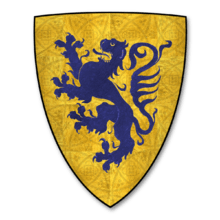 . He was a son of Godfrey I, Count of Louvain of the House of Louvain, ancestor of the dukes of Brabant
. He was a son of Godfrey I, Count of Louvain of the House of Louvain, ancestor of the dukes of Brabant  , House of Hesse, and so the Mountbattens) either by his second wife, Clementia of Burgundy, or by a mistress (see Dukes of Brabant family tree). He was also brother-in-law to King Henry I, whose second wife was Joscelin's step-sister Adeliza of Louvain.
, House of Hesse, and so the Mountbattens) either by his second wife, Clementia of Burgundy, or by a mistress (see Dukes of Brabant family tree). He was also brother-in-law to King Henry I, whose second wife was Joscelin's step-sister Adeliza of Louvain. - Richard de Percy (d. 1244),[18] 5th feudal baron of Topcliffe, signatory to Magna Carta. Died childless. Succeeded his elder brother Henry de Percy (d.1198), the 4th Baron Topcliffe, whose son William III de Percy (1197-1245) became Richard's heir.[18]
- William de Percy, (1197–1245), 6th feudal baron of Topcliffe
- Henry de Percy, 7th feudal baron of Topcliffe (1228–1272)
- Henry de Percy, 1st Baron Percy of Alnwick (1273–1314), 7th feudal baron of Topcliffe and 1st baron by writ.
- Henry de Percy, 2nd Baron Percy of Alnwick (1299–1352)
- Henry de Percy, 3rd Baron Percy of Alnwick (see below)
- Thomas Percy (d. 1369), Bishop of Norwich
- Henry de Percy, 3rd Baron Percy of Alnwick (1320–1368)
- Henry Percy, 1st Earl of Northumberland (1341–1408) (forfeit 1405), helped Henry IV seize the throne, later rebelled against him
- Sir Henry Percy (1364/1366–1403), also called Harry Hotspur, helped Henry IV seize the throne but later rebelled against him, killed at the Battle of Shrewsbury
- Henry Percy, 2nd Earl of Northumberland (see below)
- Lady Elizabeth Percy (c. 1390 – 1437)
- Henry Percy, 2nd Earl of Northumberland (1394–1455), supporter of King Henry VI, killed at the beginning of the Wars of the Roses
- Henry Percy, 3rd Earl of Northumberland (see below)
- Thomas Percy, 1st Baron Egremont (1422–1460)
- Katherine Percy, Countess of Kent (1423 – c. 1475)
- Ralph Percy (d.1464), knight, Lancastrian supporter in the Wars of the Roses
- William Percy (1428–1462), Bishop of Carlisle
- Henry Percy, 3rd Earl of Northumberland (1421–1461) (forfeit 1461), Lancastrian leader in the Wars of the Roses
- Henry Percy, 4th Earl of Northumberland (see below)
- Margaret Percy (b. c. 1447)
- Henry Percy, 4th Earl of Northumberland (1449–1489) (restored 1470), aligned with Yorkists, present but inactive at the Battle of Bosworth Field
- Henry Algernon Percy, 5th Earl of Northumberland (see below)
- Eleanor Percy, Duchess of Buckingham (1474–1530), daughter of the 4th Earl
- Alan Percy (c. 1480 – 1560), son of the 4th Earl, English churchman and academic
- Anne FitzAlan, Countess of Arundel (1485–1552), daughter of the 4th Earl
- Thomas Percy (1560–1605), great-grandson of the 4th Earl, participated in the Gunpowder Plot
- Henry Algernon Percy, 5th Earl of Northumberland (1478–1527)
- Henry Percy, 6th Earl of Northumberland (1502–1537), betrothed to Anne Boleyn
- Thomas Percy (c. 1504 – 1537), participated the Pilgrimage of Grace revolt
- Blessed Thomas Percy, 7th Earl of Northumberland (1528–1572) (forfeit 1571; restored 1572), led the Rising of the North
- Henry Percy, 8th Earl of Northumberland (see below)
- Henry Percy, 8th Earl of Northumberland (1532–1585)
- Henry Percy, 9th Earl of Northumberland (see below)
- George Percy (1580–1632), explorer, author, early governor of Virginia
- Henry Percy, 9th Earl of Northumberland (1564–1632), known as "The Wizard Earl" for his intellectual pursuits, imprisoned after the Gunpowder Plot
- Dorothy Sidney, Countess of Leicester (c. 1598 – 1659)
- Lucy Hay, Countess of Carlisle (1599–1660)
- Algernon Percy, 10th Earl of Northumberland (see below)
- Henry Percy, Baron Percy of Alnwick (d.1659), royalist in the English Civil War
- Algernon Percy, 10th Earl of Northumberland (1602–1668), Lord High Admiral of England, later a Parliamentarian in the English Civil War
- Joceline Percy, 11th Earl of Northumberland (1644–1670), no male heirs, becomes the last male of direct Percy lineage to inherit the Earldom.
- Elizabeth Seymour, Duchess of Somerset (1667–1722), only daughter and heiress of the 11th Earl
- Algernon Seymour, 7th Duke of Somerset, 1st Earl of Northumberland (1684–1750), son of Elizabeth Seymour

- Elizabeth Percy (née Seymour), Duchess of Northumberland, 2nd Baroness Percy (1716–1776), daughter and heiress of the 7th Duke of Somerset, married Sir Hugh Smithson (who adopted the name Percy)
- Hugh Percy, 1st Duke of Northumberland (1714–1786), né Smithson
- Hugh Percy, 2nd Duke of Northumberland (1742–1817), British army officer during the American Revolutionary War
- Hugh Percy, 3rd Duke of Northumberland (1785–1847)
- Algernon Percy, 4th Duke of Northumberland (1792–1865)
- Algernon Percy, 1st Earl of Beverley (1750–1830), second son of the 1st Duke
- George Percy, 2nd Earl of Beverley, 5th Duke of Northumberland (see below)
- Algernon Percy (1779–1833), diplomat
- Hugh Percy (1784–1856), bishop
- Josceline Percy (1784–1856), Royal Navy officer
- William Henry Percy (1788–1855), Royal Navy officer
- James Smithson (1764–1829), illegitimate son of the 1st Duke, associated with the Smithsonian Institution and smithsonite
- Hugh Percy, 2nd Duke of Northumberland (1742–1817), British army officer during the American Revolutionary War
- George Percy, 2nd Earl of Beverley, 5th Duke of Northumberland (1778–1867), politician
- Algernon George Percy, 6th Duke of Northumberland (see below)
- Lord Josceline Percy (1811–1881), politician
- Lord Henry Percy (1817–1877), lieutenant-general in the British Army
- Algernon George Percy, 6th Duke of Northumberland (1810–1899), politician
- Henry George Percy, 7th Duke of Northumberland (see below)
- Lord Algernon Percy (1851–1933), politician
- Henry George Percy, 7th Duke of Northumberland (1846–1918), politician
- Henry Percy, Earl Percy (1871–1909), politician
- Alan Ian Percy, 8th Duke of Northumberland (see below)
- Eustace Percy, 1st Baron Percy of Newcastle (1887–1958), politician
- Alan Ian Percy, 8th Duke of Northumberland (1880–1930)
- Henry George Alan Percy, 9th Duke of Northumberland (1912–1940), killed in World War II
- Hugh Algernon Percy, 10th Duke of Northumberland (see below)
- Elizabeth Douglas-Hamilton, Duchess of Hamilton and Brandon (1916–2008)
- Hugh Algernon Percy, 10th Duke of Northumberland (1914–1988)
- Henry Alan Walter Richard Percy, 11th Duke of Northumberland (1953–1995)
- Ralph George Algernon Percy, 12th Duke of Northumberland (b. 1956)
- George Dominic Percy, Earl Percy (b. 4 May 1984)
Family Tree
| William de Perci aux Gernons ("with whiskers", later became a common name in the family, "Algernon") arrived in England from Normandy 1067 from Percy-en-Auge in Normandy 1st feudal baron of Topcliffe, North Yorkshire (d. 1096/9) | |||||||||||||||||||||||||||||||||||||||||||||||||||||||||||||||||||||||||||||||||||||||||||||||||||||||||||
| Alan de Perci 2nd feudal baron of Topcliffe (d. circa 1130/5) | |||||||||||||||||||||||||||||||||||||||||||||||||||||||||||||||||||||||||||||||||||||||||||||||||||||||||||
| William II de Perci (d. 1174/5) 3rd feudal baron of Topcliffe | Godfrey I, Count of Louvain | Ida of Chiny (1078–1117) | |||||||||||||||||||||||||||||||||||||||||||||||||||||||||||||||||||||||||||||||||||||||||||||||||||||||||
| Agnes de Perci (1134-1205) | Joscelin of Louvain (d.1180) 4th feudal baron of Topcliffe | Adeliza of Louvain | 2. King Henry I of England 1. | Matilda of Scotland | Dukes of Brabant | ||||||||||||||||||||||||||||||||||||||||||||||||||||||||||||||||||||||||||||||||||||||||||||||||||||||
| Henry de Perci | Richard de Perci (d. 1244) 5th feudal baron of Topcliffe | Empress Matilda | William Adelin | House of Hesse Mountbattens | |||||||||||||||||||||||||||||||||||||||||||||||||||||||||||||||||||||||||||||||||||||||||||||||||||||||
| William III de Perci (1197-1245) 6th feudal baron of Topcliffe | King Henry II "FitzEmpress" of England | ||||||||||||||||||||||||||||||||||||||||||||||||||||||||||||||||||||||||||||||||||||||||||||||||||||||||||
| Henry de Perci (1228–1272) 7th feudal baron of Topcliffe | |||||||||||||||||||||||||||||||||||||||||||||||||||||||||||||||||||||||||||||||||||||||||||||||||||||||||||
| Henri de Perci 8th feudal baron of Topcliffe 1st Baron Percy of Alnwick by writ. (1273–1314) | |||||||||||||||||||||||||||||||||||||||||||||||||||||||||||||||||||||||||||||||||||||||||||||||||||||||||||
| Henry de Percy 9th feudal baron of Topcliffe 2nd Baron Percy of Alnwick (1299–1352) | |||||||||||||||||||||||||||||||||||||||||||||||||||||||||||||||||||||||||||||||||||||||||||||||||||||||||||
| Henry de Percy 10th feudal baron of Topcliffe 3rd Baron Percy of Alnwick (1320–1368) | Mary of Lancaster | Thomas Percy bishop of Norwich (d. 1369) | |||||||||||||||||||||||||||||||||||||||||||||||||||||||||||||||||||||||||||||||||||||||||||||||||||||||||
| Margaret Neville | Henry Percy 11th feudal baron of Topcliffe 4th Baron Percy of Alnwick 1st Earl of Northumberland, 1377 forfeit 1405 (1341–1408) | Maud Lucy heiress of Egremont | Thomas Percy 1st Earl of Worcester (1343 – 1403)  | ||||||||||||||||||||||||||||||||||||||||||||||||||||||||||||||||||||||||||||||||||||||||||||||||||||||||
| Henry Percy (Hotspur) (1364 – 1403) | Thomas Percy | Ralph Percy | Alan Percy | Mary Percy | |||||||||||||||||||||||||||||||||||||||||||||||||||||||||||||||||||||||||||||||||||||||||||||||||||||||
| Elizabeth (c. 1390 – 1437) | Henry Percy 2nd Earl of Northumberland, 1416 (1394–1455) | ||||||||||||||||||||||||||||||||||||||||||||||||||||||||||||||||||||||||||||||||||||||||||||||||||||||||||
| Henry 3rd Earl of Northumberland (1421 - 1461 ) | Thomas Percy 1st Baron Egremont (1422 – 1460) | Katherine (1423 Aft. 1475 ) | George Percy (1424 - 1474 ) | Ralph Percy ( 1425 - 1464) | Richard Percy | William Percy Bishop of Carlise (1428 – 1462) | Joan Percy (1430 - 1482) married Lord Edmund d'Aganet, 8th Baron of Blyth | Anne Percy (1436 - 1522) married Thomas Hungerford of Rowden </small? | |||||||||||||||||||||||||||||||||||||||||||||||||||||||||||||||||||||||||||||||||||||||||||||||||||
| Henry Percy 4th Earl of Northumberland (1449–1489) (restored 1470) | Sir Ralph Percy | Peter Percy | Sir Henry Percy | George Percy | John Percy | ||||||||||||||||||||||||||||||||||||||||||||||||||||||||||||||||||||||||||||||||||||||||||||||||||||||
| Henry Algernon Percy 5th Earl of Northumberland (1478–1527) | Alan Percy (c. 1480 – 1560) | Joscelin Percy | |||||||||||||||||||||||||||||||||||||||||||||||||||||||||||||||||||||||||||||||||||||||||||||||||||||||||
| Henry Percy 6th Earl of Northumberland (1502–1537) , betrothed to Anne Boleyn | Thomas Percy (c. 1504 – 1537) participated the Pilgrimage of Grace revolt | Edward Percy | |||||||||||||||||||||||||||||||||||||||||||||||||||||||||||||||||||||||||||||||||||||||||||||||||||||||||
| Thomas Percy 7th Earl of Northumberland (forfeit 1571; restored 1572) led the Rising of the North (1528–1572) | Henry Percy 8th Earl of Northumberland (1532–1585) | Thomas Percy convicted in the Gunpowder Plot (c. 1560 – 1605) | |||||||||||||||||||||||||||||||||||||||||||||||||||||||||||||||||||||||||||||||||||||||||||||||||||||||||
| Henry Percy 9th Earl of Northumberland "the Wizard Earl" (1564–1632) | Thomas Percy | William Percy | Sir Charles Percy | Richard Percy | Sir Joscelin Percy | Sir Alan Percy | Sir George Percy explorer, author, gov. of Virginia (1580–1632) | ||||||||||||||||||||||||||||||||||||||||||||||||||||||||||||||||||||||||||||||||||||||||||||||||||||
| Algernon Percy 10th Earl of Northumberland (1602–1668) Lord High Admiral of England, later a Parliamentarian in the English Civil War | Henry Percy Baron Percy of Alnwick (d.1659) royalist in the English Civil War | ||||||||||||||||||||||||||||||||||||||||||||||||||||||||||||||||||||||||||||||||||||||||||||||||||||||||||
| Joceline Percy 11th Earl of Northumberland (1644–1670) no male heirs, becomes the last male of direct Percy lineage to inherit the Earldom | |||||||||||||||||||||||||||||||||||||||||||||||||||||||||||||||||||||||||||||||||||||||||||||||||||||||||||
| Henry Percy Lord Percy (1668–1669) only son and heir apparent | Elizabeth Percy suo jure Baroness Percy (1667 – 1722) | Charles Seymour, 6th Duke of Somerset | |||||||||||||||||||||||||||||||||||||||||||||||||||||||||||||||||||||||||||||||||||||||||||||||||||||||||
| Algernon Seymour, 7th Duke of Somerset Baron Percy (1684 – 1750) created Earl of Northumberland, with remainder to his son-in-law | |||||||||||||||||||||||||||||||||||||||||||||||||||||||||||||||||||||||||||||||||||||||||||||||||||||||||||
| George Seymour Viscount Beauchamp (1725 – 1744) | Elizabeth Percy suo jure 2nd Baroness Percy (1730 - 1776) | Sir Hugh Percy né Smithson 4th Baronet Smithson 2nd Earl of Northumberland by right of his wife,1750, and 1st Duke of Northumberland by creation 1766 (1714 – 1786) | |||||||||||||||||||||||||||||||||||||||||||||||||||||||||||||||||||||||||||||||||||||||||||||||||||||||||
This summary genealogical tree shows how the current house of Percy is related:
| Hugh Percy, 1st Duke of Northumberland 1714–1786 | |||||||||||||||||||||||||||||||||
| Hugh Percy, 2nd Duke of Northumberland 1742–1817 | Algernon Percy, 1st Earl of Beverley 1750–1830 | ||||||||||||||||||||||||||||||||
| Hugh Percy, 3rd Duke of Northumberland 1785–1847 | Algernon Percy, 4th Duke of Northumberland 1792–1865 | George Percy, 5th Duke of Northumberland 1778–1867 | |||||||||||||||||||||||||||||||
| Algernon Percy, 6th Duke of Northumberland 1810–1899 | |||||||||||||||||||||||||||||||||
| Henry Percy, 7th Duke of Northumberland 1846–1918 | |||||||||||||||||||||||||||||||||
| Alan Percy, 8th Duke of Northumberland 1880–1930 | |||||||||||||||||||||||||||||||||
| Henry Percy, 9th Duke of Northumberland 1912–1940 | Hugh Percy, 10th Duke of Northumberland 1914–1988 | ||||||||||||||||||||||||||||||||
| Henry Percy, 11th Duke of Northumberland 1953–1995 | Ralph Percy, 12th Duke of Northumberland b. 1956 | ||||||||||||||||||||||||||||||||
Coats of Arms
Paternal arms of Henry de Percy, 1st Baron Percy (1273–1314): Azure, five fusils in fess or,[19]("Percy ancient") which he abandoned in favour of right: Or, a lion rampant azure ("Percy modern"/Brabant)[20] Both arms were quartered by the Percy Earls of Northumberland and remain quartered by the present Duke of Northumberland
 Arms of original de Perci family
Arms of original de Perci family Arms of the Percy family descended from Joscelin de Louvain
Arms of the Percy family descended from Joscelin de Louvain Sir Henry Percy, 1st Earl of Northumberland, KG
Sir Henry Percy, 1st Earl of Northumberland, KG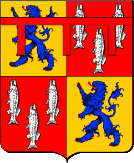 Henry Percy, "Hotspur"
Henry Percy, "Hotspur"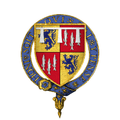 Sir Henry "Hotspur" Percy, KG.png
Sir Henry "Hotspur" Percy, KG.png Sir Henry Percy, 4th Earl of Northumberland, KG
Sir Henry Percy, 4th Earl of Northumberland, KG Sir Henry Algernon Percy, 5th Earl of Northumberland, KG
Sir Henry Algernon Percy, 5th Earl of Northumberland, KG Sir Henry Percy, 6th Earl of Northumberland, KG
Sir Henry Percy, 6th Earl of Northumberland, KG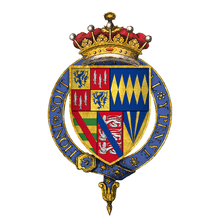 Sir Thomas Percy, 7th Earl of Northumberland, KG
Sir Thomas Percy, 7th Earl of Northumberland, KG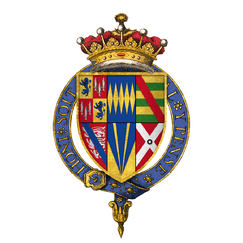 Sir Henry Percy, 9th Earl of Northumberland, KG
Sir Henry Percy, 9th Earl of Northumberland, KG Sir Algernon Percy, 10 Earl of Northumberland, KG
Sir Algernon Percy, 10 Earl of Northumberland, KG- Arms of Smithson of Stanwick, Yorkshire (ancient): Argent, a chevron engrailed sable between three oak leaves erect slipped vert[21]
- Augmented arms of Smithson Baronets of Stanwick to Sir Hugh Smithson, 1st Baronet by King Charles II of England for loyalty: Or, on a chief embattled azure three suns proper[22]
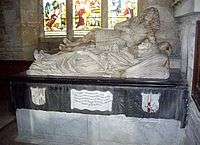 Monument of Sir Hugh Smithson, 1st Baronet (d.1670), St John the Baptist's Church, Stanwick, Yorks.[23]
Monument of Sir Hugh Smithson, 1st Baronet (d.1670), St John the Baptist's Church, Stanwick, Yorks.[23] Duke of Northumberland
Duke of Northumberland
Building work by the Percy family
- Topcliffe Castle, Yorkshire, recorded in the Domesday Book of 1086 as held by William I de Percy (d.1096), whom it served as the caput of the feudal barony of Topcliffe. The Percy family's most ancient English seat.
- Petworth, Sussex, acquired by Joscelin of Louvain (d.1180), husband of Agnes de Percy, one of the two daughters and co-heiresses of William II de Percy (d.1174/5), feudal baron of Topcliffe in Yorkshire (grandson of William I de Percy (d.1096)). Jocelin's younger son Richard "de Percy" (d.1244) adopted the surname "de Percy" and inherited his father's estate of Petworth and a moiety of his maternal barony of Topcliffe. Richard died without progeny when his estates descended to his nephew William III "de Percy" (1197-1245), grandson of Jocelin de Louvain, who had inherited the other moiety of Topcliffe from his great-aunt Maud de Percy.[24]
.svg.png)
- Alnwick Castle, Northumberland, purchased in 1309 by Henry de Percy, 1st Baron Percy (1273–1314) from Anthony Bek, Prince Bishop of Durham.[25]
- Warkworth Castle, Northumberland
- Cockermouth Castle, Cumbria, inherited by Henry Percy, 1st Earl of Northumberland (1341-1408) and his heirs male, from his 2nd wife Maud de Lucy, sister and heiress of Anthony de Lucy, 3rd Baron Lucy (d.1368), on condition that they should bear the arms of Lucy (Gules, three lucies hauriant argent) quarterly with their own.[26]
- Egremont Castle, Cumbria, purchased in 1529 by Henry Percy, 15th Earl of Northumberland from Robert Radclyffe, 1st Earl of Sussex (1483–1542).[27]
- Leconfield Castle, Yorksire.
- Syon House, Isleworth, Middlesex, the former Syon Monastery, acquired in 1594 by Henry Percy, 9th Earl of Northumberland (1564-1632).
Following the death of his grandson Algernon Seymour, 7th Duke of Somerset in 1750, the former Percy estates were split between the Smithson ("Percy", Duke of Northumberland) and Wyndham (Earl of Egremont) families
See also
References
- ↑ Debrett's Peerage, 1968, p.849
- ↑ Burke's General Armory, 1884 & Landed Gentry
- ↑ Smith-Ellis, W., Antiquities of Heraldry, Vol. 1, pp.204-5, who suggests that a Roll of Arms c.1308-14 temp. Edward II lists the arms of Redvers as abatue or extinct and states in the same roll that they were borne by Sir Henry de Percy, whose father was heir of his 2nd brother Ingelram, who married Adeline, daughter and heiress of William de Fors by Isabel, daughter and heiress of Baldwin de Rivers, Earl of Devon. The Courtenays were also heirs of Isabel de Fors, and also quarter the Redvers lion
- 1 2 3 Sanders, I.J., English Baronies, Oxford, 1960, p.148
- ↑ Rose, Alexander (2003). Kings in the North. The House of Percy in British History. London: Phoenix. pp. 26–7. ISBN 1-84212-485-4. Retrieved 2011-05-21.
- ↑ Rose, Alexander (2003). Kings in the North. The House of Percy in British History. London: Phoenix. pp. 86–9. ISBN 1-84212-485-4. Retrieved 2011-05-21.
- 1 2 3 4 5 6 Northumberland Yesterday and To-day by Jean F. Terry, 1913, from Project Gutenberg
- ↑ The London Gazette: no. 8887. p. 2. 23 September 1749.
- ↑ Debrett's Peerage, 1968, p.1037
- ↑ Debrett's Peerage, 1968, p.851
- ↑ The London Gazette: no. 12514. p. 2. 27 January 1784.
- ↑ The London Gazette: no. 13249. p. 646. 26 October 1790.
- ↑ The London Gazette: no. 16583. p. 497. 14 March 1812.
- ↑ The London Gazette: no. 17164. p. 1596. 17 August 1816.
- ↑ The London Gazette: no. 25723. p. 4001. 22 July 1887.
- ↑ Alnwick Castle website
- ↑ Syon House website
- 1 2 3 4 Sanders
- ↑ Debrett's Peerage, 1968, p.849, Duke of Northumberland
- ↑ Howard de Walden, Lord, Some Feudal Lords and their Seals 1301, published 1904, p.43
- ↑ Collins' Baronetage of England; The old arms can be seen carved in wood impaling the arms of Fairfax (A lion rampant) on the staircase of Moulton Hall, Richmond, York, made following the 1653 marriage of George Smithson. See image in: Smithson, George R., Genealogical notes memoirs of the Smithson family, London, 1906, plate between pp.24&25
- ↑ Collins, Arthur, The English Baronetage, vol.3, part 1; Victoria County History, Stanwick St John
- ↑ Further reading: The Smithson Monuments at Stanwick, North Yorkshire by Bulter, L., published in Journal of the Church Monument Society Volume XV, 2000. 6pp, 4 b/w pls
- ↑ Sanders, I.J., English Baronies, Oxford, 1960, p.148, Topcliffe, Yorkshire
- ↑ Sanders, I.J., English Baronies, Oxford, 1960, p.103, Alnwick, Northumberland
- ↑ Daniel Lysons and Samuel Lysons, 'Cockermouth', in Magna Britannia: Volume 4, Cumberland (London, 1816), pp. 40-45 http://www.british-history.ac.uk/magna-britannia/vol4/pp40-45
- ↑ http://www.edgeguide.co.uk/cumbria/egremontcastle.html
